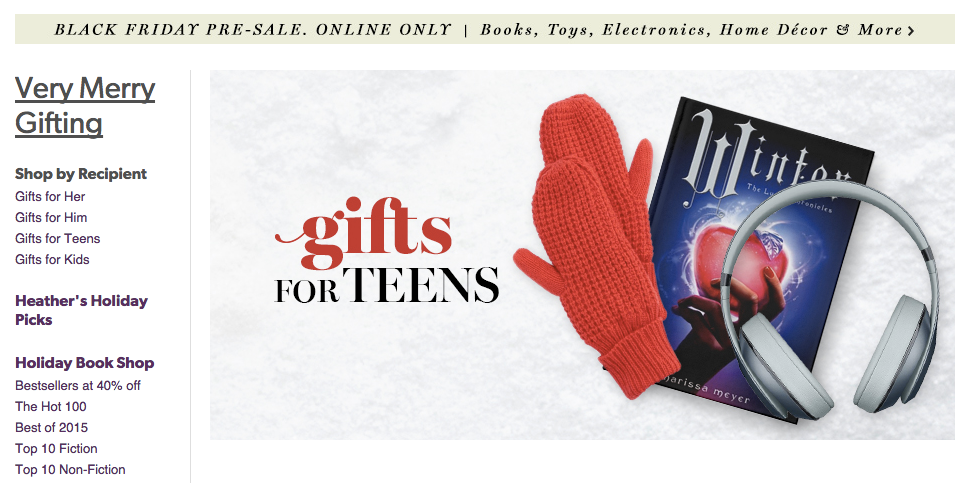The holidays do funny things to people. Maybe it’s leftover anticipation from all those childhood Christmases. Maybe it’s whatever fun stuff Uncle Bill is putting in his homemade eggnog. Either way, if you take a good look at folks in November and December, you’ll see some odd behaviour.
Here at Pixel Union, we’re not just getting ready to decorate the office and draw names for Secret Santa — we’re helping our merchants get their stores ready for the holidays. As a theme provider, we’ve found that the more we understand about buyer psychology, the better we’re able to support our customers. When merchants come to us for advice about holiday sales, the first thing we tell them is to put themselves in their customers’ shoes.
We’re fortunate to have great relationships with the merchants who use our themes. They’re constantly teaching us about changes in buyer behaviour, and about the different things online stores can do to convert better and maximize revenue during the holiday season.
With that, here are five things to keep in mind about holiday buyer psychology, what it means for online merchants, and what you can expect when it comes to supporting them.
You might also like: 4 Ways to Give Some Holiday Flair to an Ecommerce Store
1. Most people aren’t shopping for themselves
This is such an obvious one, but it’s surprising how many merchants forget about it. For shoppers, the months of November and December are all about gift-buying. Sure, a merchant who sells dinnerware or ugly Christmas sweaters might have a different experience, but most online store owners need to shift their focus from shoppers themselves to the visions of friends and family dancing in those shoppers’ heads.
One strategy to consider is creating recipient-specific gift guides to help shoppers who are looking to fill specific needs but don’t know where to begin. Another is organizing inventory by persona — parents, children, colleagues, etc. If a merchant can find a way to provide inspiring, practical solutions to stressed-out holiday shoppers, they’ll have an immediate competitive advantage.

On the flip side, personalization apps — on every merchant’s wishlist for their ability to store and analyze customer data and make smart product suggestions — lose some of their value during the holidays. We’re super interested in apps like LimeSpot and Nosto, but if we were running one of them in our own store, we’d consider disabling it during the holidays.
Social expectations also change buyer behaviour. Think about it: when deciding between low-end and high-end golf clubs, it’s a lot easier to settle for the cheap clubs when you don’t have to wrap them up and give them to someone. One pricing strategy that’s proven to work is to leave low-end options as is and slash the price of upper-end models. If a customer sees a set of great clubs at an even better price and can give something with a lot of perceived value, they’ll be more willing to spend (and might even buy a set of their own).
Bundling products is a chip off the same fairway. Customers will be more inclined to buy the pricier clubs if they can throw them into a free bag. A merchant might also try running recommended products and letting customers bundle less-expensive gifts. How about a discounted set of golf shoes, golf socks and sunglasses for old Uncle Bill?
2. Holiday shoppers are more willing to spend
Speaking of social expectations, many researchers have examined the herd mentality that develops among holiday shoppers. One of our favourite studies is by University of Michigan professor Scott Rick, who suggests there are two kinds of shoppers: “tightwads,” who cling to their money, spending little and eventually wishing they had spent more, and “spendthrifts,” who spend more freely but ultimately regret their extravagance.
For most of the year, it’s easy to distinguish the spending of these two groups, but when it comes to the holidays, behaviours converge. That’s because spending money on someone else eases the pain of purchasing. Put another way, buying gifts isn’t so much a choice as a necessity. According to Rick, “The pain of paying matters most when purchases are optional. Gifts for loved ones are not optional, assuming we want to maintain those relationships.”

With psychological purchasing barriers relaxed, the smart move for merchants is to relax any in-store (or on-page) barriers. That could mean implementing a quick-shop function on product listing pages, either by leveraging Shopify’s Ajax API or by integrating an existing Ajax cart library like Cart.js. It could also be something as simple as advertising an easy return policy, optional gift receipt, free shipping — or all of the above.
In a certain sense, buyer psychology boils down to education. “Tightwad” shoppers, who don’t have as much experience purchasing online, are naturally going to have some trepidation about checking out. Anything a merchant can do to ease that pain is going to be valuable.
3. Everyone is looking for a discount
We’ve talked a little about discounts already, but it’s important to keep in mind that discounts are everywhere in November and December, and everybody is looking for one. For most holiday shoppers, a good deal is way more important than brand loyalty or after-sales service.
Merchants should do everything they can to advertise discounts. Don’t stop at highlighting discounted products on the homepage. Make the discount as clear as possible on the product detail page. Show customers a percentage figure or total dollar amount of how much they’re saving. Reinforce the value of the discount throughout the checkout process.

Even if a merchant’s margins are slim, a five-percent discount can go a long way toward winning over consumers. Given how today’s shoppers are conditioned to expect deals — especially during the holiday season — buying a product at full price can feel like a loss.
You might also like: 7 Tips to Help Your Clients Sell More This Holiday Season
4. People have a lot to do in a short amount of time
The holidays are an extremely busy time of year. Shopping aside, there are vacations to plan, parties to attend, and work that needs to be finished before taking time off.
When it comes to gift-buying, the typical shopper’s goal is to find something “good enough” in a short amount of time. That doesn’t mean they’ll buy the first thing they see, only that they’ll be be more rushed and less patient when comparing multiple options.
There are lots of things online merchants can do to keep shoppers from bouncing — pick a good theme, take good product photos, write clear product descriptions, organize their catalogue effectively — but enabling comparison-shopping is something that works especially well during the busy holiday period. Take a page from Apple’s book: make it easy for customers to compare prices and product details to determine the best option without leaving for another store.

Exit-intent popups are another way of enticing shoppers to stick around. An additional discount or other special offer can be the extra nudge a customer needs to get to the checkout. Let them know the clock is ticking, limited quantities remain — the time to buy is now.
5. Shipping is top of mind
The world is full of procrastinators. As much as we promise to change, as often as we tell ourselves this will be the year, next year will be the year, one of these years we’ll finally get it right — there will never be a December without legions of last-minute shoppers.
Free shipping is always a great option for enticing customers, but when it comes to the holidays, fast shipping can be even better. Merchants should have a strategy for expedited shipping — and they should flaunt it. Even if it’s not the eleventh hour, many buyers prefer to have their gifts in hand as soon as possible so they can cross items off their to-do list. They might also be inclined to add more products to their order if they’re already paying for that service.
As a general rule, buyers get extra worked up about shipping during the holidays, and there’s plenty merchants can do to alleviate those concerns. Providing a shop-by/arrive-in-time calendar is one way of giving shoppers assurance when they’re making purchases.
Another smart course of action is to implement shipping notifications via email or text message, to cut down on customer service tickets. AfterShip, Shippo and ShipStation are just a few of the many shipping apps that offer this feature. We’re sure there are lots of time-crunched store owners out there who wish they had implemented this sooner.
Keep buyer psychology front-of-mind
Buyer psychology is a fickle and ever-changing thing. With these key points in mind, you should be ready to guide and support your clients over the holidays — but we suggest keeping your eyes and ears open and doing some more research of your own. Talk to online store owners about the things they do differently during the holidays. Ask them about their customers’ behaviour and how it changes in November and December. And finally, when you’re doing your own holiday shopping, think about your own psychology and how it’s different from the rest of the year — you might be surprised by how dramatically your habits change.
You might also like: How to Support Your Clients Over the Holidays









